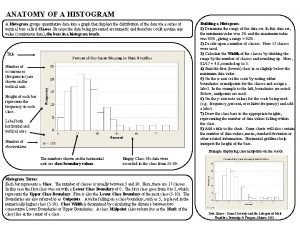ANATOMY OF A HISTOGRAM A Histogram groups quantitative

- Slides: 1

ANATOMY OF A HISTOGRAM A Histogram groups quantitative data into a graph that displays the distribution of the data via a series of vertical bars called Classes. Because the data being presented are numeric and therefore could assume any value (continuous data), the bars in a histogram touch. Title Number of occurrences (frequencies) are shown on the vertical axis. Height of each bar represents the frequency in each class. Label both horizontal and vertical axes. Number of observations Building a Histogram: 1) Determine the range of the data set. In this data set, the minimum value was 1% and the maximum value was 83%, giving a range = 82%. 2) Decide upon a number of classes. Here 17 classes were used. 3) Calculate the Width of the classes by dividing the range by the number of classes and rounding up. Here, 82/17 = 4. 8, rounded up to 5. 4) Start the first (lowest) class at or slightly below the minimum data value. 5) On the x-axis set the scale by noting either boundaries or midpoints for the classes and assign a label. In the example to the left, boundaries are noted. Below, midpoints are used. 6) On the y-axis note values for the scale being used (e. g. frequency, percent, or relative frequency) and add a label. 7) Draw the class bars to the appropriate heights, representing the number of data values falling within the class. 8) Add a title to the chart. Some charts will also contain the number of data values, mean, standard deviation or other related information. Horizontal gridlines help interpret the height of the bars. Example displaying class midpoints on the x-axis. The numbers shown on the horizontal axis are class boundary values. Empty Class: No data were recorded in the class from 55 -60. Histogram Terms: Each bar represents a Class. The number of classes is usually between 5 and 20. Here, there are 17 classes. In this case the first class was set with a Lower Class Boundary of 0. The first class goes from 0 to 5, which represents the Upper Class Boundary. Five is also the Lower Class Boundary of the next class (5 -10). The Boundaries are also referred to as Cutpoints. A value falling on a class boundary, such as 5, is placed in the numerically higher class (5 -10). Class Width is determined by calculating the distance between two consecutive Lower Boundaries or Upper Boundaries. A class Midpoint (also referred to as the Mark of the class) lies at the center of a class. . Data Source: Sexual Activity and the Lifespan of Male Fruitflies, Partridge & Farquar, Nature, 1981.

